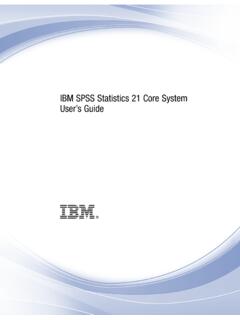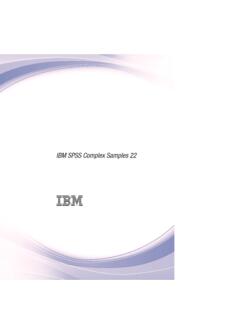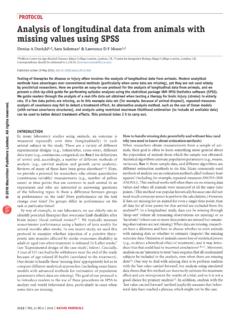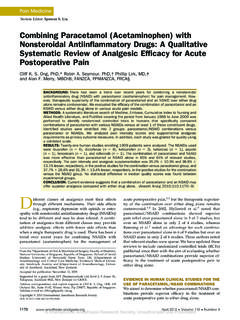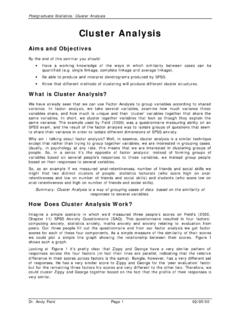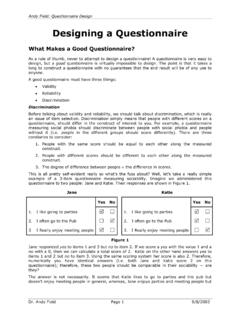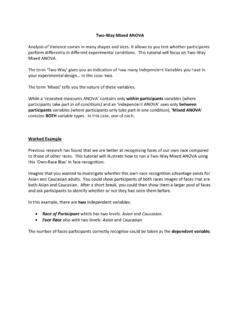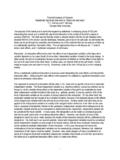Transcription of IBM SPSS Amos 22 User’s Guide - University of Sussex
1 IBM spss amos 22 user s GuideJames L. ArbuckleNote: Before using this information and the product it supports, read the information in the Notices edition applies to IBM spss amos 22 and to all subsequent releases and modifications until otherwise indicated in new product screenshots reproduced with permission from Microsoft Materials - Property of IBM Copyright IBM Corp. 1983, 2013. Government Users Restricted Rights - Use, duplication or disclosure restricted by GSA ADP Schedule Contract with IBM Corp. Copyright 2013 amos Development Corporation. All Rights is a trademark of amos Development I: Getting Started1 Introduction1 Featured Methods .. 2 About the Tutorial.
2 3 About the Examples .. 3 About the Documentation .. 4 Other Sources of Information .. 4 Acknowledgements .. 52 Tutorial: Getting Started with amos Graphics7 Introduction .. 7 About the Data .. 8 Launching amos Graphics .. 9 Creating a New Model.. 10 Specifying the Data File .. 11 Specifying the Model and Drawing Variables .. 11 Naming the Variables .. 12 Drawing Arrows .. 13 Constraining a Parameter .. 14 Altering the Appearance of a Path Diagram .. 15To Move an Object .. 15To Reshape an Object or Double-Headed Arrow .. 15To Delete an Object.. 15To Undo an Action .. 16To Redo an Action .. 16ivSetting Up Optional Output .. 16 Performing the Analysis.
3 18 Viewing Output .. 18To View Text Output .. 18To View Graphics Output .. 19 Printing the Path Diagram.. 20 Copying the Path Diagram .. 21 Copying Text Output .. 21 Part II: Examples1 Estimating Variances and Covariances23 Introduction .. 23 About the Data .. 23 Bringing In the Data .. 24 Analyzing the Data .. 25 Specifying the Model.. 25 Naming the Variables .. 26 Changing the Font .. 27 Establishing Covariances .. 27 Performing the Analysis .. 28 Viewing Graphics Output .. 28 Viewing Text Output .. 29 Optional Output .. 33 Calculating Standardized Estimates .. 33 Rerunning the Analysis .. 34 Viewing Correlation Estimates as Text Output.
4 34 Distribution Assumptions for amos Models .. 35 Modeling in .. 36 Generating Additional Output .. 39 Modeling in C# .. 39 Other Program Development Tools .. 40v2 Testing Hypotheses41 Introduction ..41 About the Data..41 Parameters Constraints ..41 Constraining Variances ..42 Specifying Equal Parameters..43 Constraining Covariances ..44 Moving and Formatting Objects ..45 Data Input ..46 Performing the Analysis..47 Viewing Text Output ..47 Optional Output ..48 Covariance Matrix Estimates ..49 Displaying Covariance and Variance Estimates on the Path Diagram ..51 Labeling Output ..51 Hypothesis Testing ..52 Displaying Chi-Square Statistics on the Path Diagram.
5 53 Modeling in ..55 Timing Is Everything ..573 More Hypothesis Testing59 Introduction ..59 About the Data..59 Bringing In the Data..59 Testing a Hypothesis That Two Variables Are Uncorrelated ..60 Specifying the Model ..60 Viewing Text Output ..62 Viewing Graphics Output ..63 Modeling in ..65vi4 Conventional Linear Regression67 Introduction .. 67 About the Data .. 67 Analysis of the Data .. 68 Specifying the Model .. 69 Identification .. 70 Fixing Regression Weights .. 70 Viewing the Text Output .. 72 Viewing Graphics Output .. 74 Viewing Additional Text Output.. 75 Modeling in .. 77 Assumptions about Correlations among Exogenous Variables .. 77 Equation Format for the AStructure Method.
6 785 Unobserved Variables81 Introduction .. 81 About the Data .. 81 Model A .. 83 Measurement Model .. 83 Structural Model .. 84 Identification .. 85 Specifying the Model .. 85 Changing the Orientation of the Drawing Area .. 86 Creating the Path Diagram .. 87 Rotating Indicators .. 88 Duplicating Measurement Models.. 88 Entering Variable Names .. 90 Completing the Structural Model .. 90 Results for Model A .. 90 Viewing the Graphics Output .. 93viiModel B ..93 Results for Model B ..94 Testing Model B against Model A..96 Modeling in ..98 Model A ..98 Model B ..996 Exploratory Analysis101 Introduction .. 101 About the Data.. 101 Model A for the Wheaton Data.
7 102 Specifying the Model .. 102 Identification .. 103 Results of the Analysis .. 103 Dealing with Rejection .. 104 Modification Indices.. 105 Model B for the Wheaton Data .. 107 Text Output .. 108 Graphics Output for Model B .. 109 Misuse of Modification Indices .. 110 Improving a Model by Adding New Constraints .. 110 Model C for the Wheaton Data .. 114 Results for Model C .. 114 Testing Model C .. 115 Parameter Estimates for Model C .. 115 Multiple Models in a Single Analysis .. 116 Output from Multiple Models .. 119 Viewing Graphics Output for Individual Models .. 119 Viewing Fit Statistics for All Four Models .. 119 Obtaining Optional Output .. 121 Obtaining Tables of Indirect, Direct, and Total Effects.
8 122viiiModeling in .. 123 Model A .. 123 Model B .. 124 Model C .. 125 Fitting Multiple Models.. 1267A Nonrecursive Model129 Introduction .. 129 About the Data .. 129 Felson and Bohrnstedt s Model .. 130 Model Identification .. 131 Results of the Analysis .. 131 Text Output .. 131 Obtaining Standardized Estimates .. 133 Obtaining Squared Multiple Correlations .. 133 Graphics Output.. 134 Stability Index .. 135 Modeling in .. 1368 Factor Analysis137 Introduction .. 137 About the Data .. 137A Common Factor Model .. 138 Identification .. 139 Specifying the Model .. 140 Drawing the Model .. 140 Results of the Analysis.
9 141 Obtaining Standardized Estimates .. 142 Viewing Standardized Estimates .. 143 Modeling in .. 144ix9An Alternative to Analysis of Covariance145 Introduction .. 145 Analysis of Covariance and Its Alternative .. 145 About the Data.. 146 Analysis of Covariance .. 147 Model A for the Olsson Data .. 147 Identification .. 148 Specifying Model A .. 149 Results for Model A .. 149 Searching for a Better Model .. 149 Requesting Modification Indices .. 149 Model B for the Olsson Data .. 150 Results for Model B .. 151 Model C for the Olsson Data .. 153 Drawing a Path Diagram for Model C .. 154 Results for Model C .. 154 Fitting All Models At Once .. 154 Modeling in.
10 155 Model A .. 155 Model B .. 155 Model C .. 156 Fitting Multiple Models .. 15710 Simultaneous Analysis of Several Groups 159 Introduction .. 159 Analysis of Several Groups .. 159 About the Data.. 160 Model A .. 160 Conventions for Specifying Group Differences .. 161 Specifying Model A .. 161 Text Output .. 166 Graphics Output .. 167xModel B .. 168 Text Output .. 170 Graphics Output.. 171 Modeling in .. 171 Model A .. 171 Model B .. 172 Multiple Model Input .. 17311 Felson and Bohrnstedt s Girls and Boys175 Introduction .. 175 Felson and Bohrnstedt s Model .. 175 About the Data .. 175 Specifying Model A for Girls and Boys .. 176 Specifying a Figure Caption.
